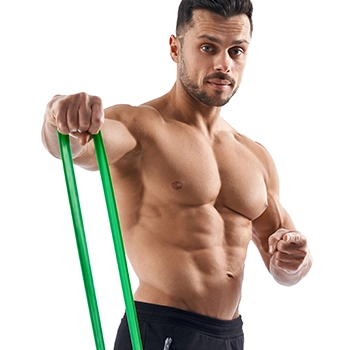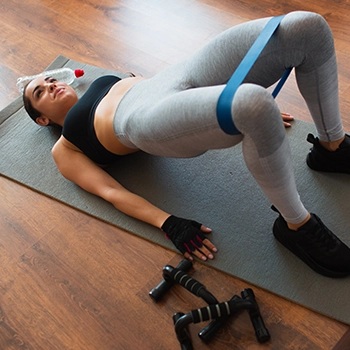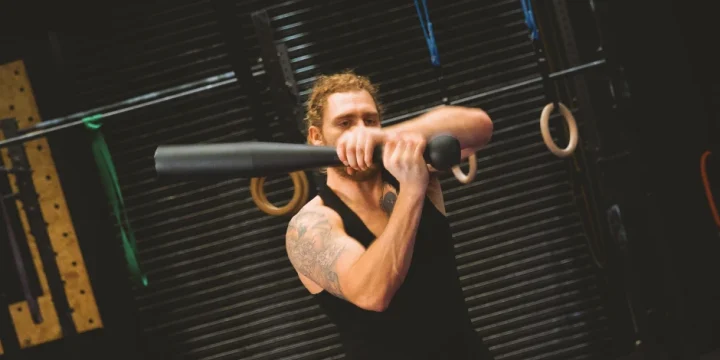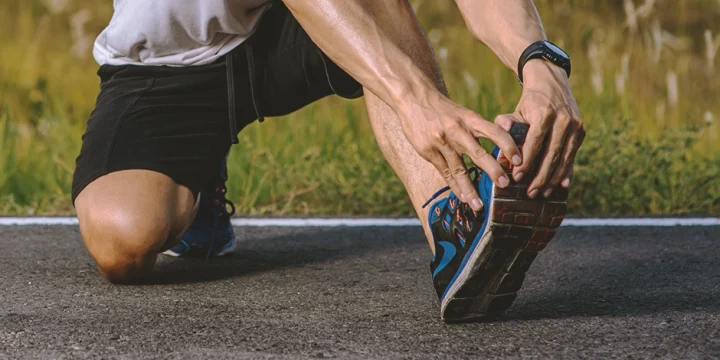Stretching and mobility exercises using resistance bands are cost-effective, convenient, and highly effective in keeping joints and muscles functioning optimally.
Since I became a fitness trainer over a decade ago, I have included resistance band exercises in countless workout plans to help clients improve and maintain flexibility and mobility.
No matter your goals or fitness level, stretching and mobility exercises are necessary for any wellness routine, and I have outlined some of the best here.
Let’s begin.
Quick Summary
- To enhance flexibility and mobility, incorporate resistance band exercises like front pull-aparts, shoulder flexion, and lateral walks into your fitness routine.
- Resistance bands are versatile tools for full-body workouts, suitable for various muscle groups, from small joints to larger muscles like quads and glutes.
- Research from the Journal of Physical Therapy Science highlights the effectiveness of resistance bands in rehabilitation due to their elasticity.
- Personally, I've found that integrating resistance band exercises into both dynamic and static stretching routines significantly improves overall mobility and muscle function.
Resistance Band Exercises for Increased Mobility

Resistance or mobility bands are widely used for rehabilitation treatments and exercises due to their elasticity, according to the Journal of Physical Therapy Science research [1].
They are a great way to achieve a full-body workout at home or on the go.
There are many types of resistance bands, and different brands use a color coding system to identify resistance quickly; however, there is no universal color code.
However, remember that the smaller diameter or width of the resistance band equates to less resistance and is suitable for working smaller joints and muscles.
Larger bands offer more resistance and are often used to work larger muscles like the quads, lats, and glutes.
Always do the following exercises with a resistance appropriate for your fitness level.
Also, consult your doctor or physical therapist before beginning any new training or stretching routine.
Related: 5 Best Mobility Exercises to Increase Your Range of Motion
1. Front Pull-Aparts
In my experience, banded front pull-aparts have been a game-changer for increasing upper back strength, especially in athletes focusing on shoulder stability.
- With arms extended in front of you, hold the resistance band horizontally.
- Your hands should be shoulder-width apart.
- Keep your upper back and neck straight.
- Do not lock your elbows.
- Keep a slight bend to your knees and your weight evenly distributed on both feet.
- Squeeze your shoulder blades together as you stretch the band laterally.
- Extend your arms as wide out to the side as possible.
- Hold briefly before returning to the starting position with a slow and controlled motion.
- Aim for two or three sets of 10–20 reps.
To maintain proper form, ensure you are working the right muscles, so don’t move your shoulders upward (shrug) when you squeeze your shoulder blades together.
You can change the difficulty of this exercise by spacing your hands closer or further apart.
2. Shoulder Flexion

This exercise helps maintain rotation and flexibility in your shoulder, which allows for arm movement.
- Begin by standing on one end of a resistance band with your right foot.
- Hold the other end in your right hand. Your thumb should face forward.
- Keep your arm to the front, and raise until your right forearm is parallel to the floor at shoulder height.
- Slowly lower back down and repeat.
- Perform 15 reps.
- Switch to the left side and do 15 reps.
3. Lateral Walks
Lateral walks with resistance bands have been a staple in my lower body routines, effectively targeting the inner thighs, glutes, and quads.
- Wrap a resistance band around both legs, just above the ankles.
- Position your feet shoulder-width apart.
- Ensure the band is taut, not stretched.
- Slightly bend your knees into a half-squat position.
- Keep your feet aligned with your shoulders and your weight evenly distributed.
- Staying in the half-squat position, shift your weight to the left leg and step sideways with the right into a wide stance as you create tension on the band.
- Move the right leg back in to complete one rep.
- Perform 8–10 reps before switching sides for another 8–10 reps.
Dynamic Stretching with Bands

Dynamic stretching lasts one to five seconds and incorporates movement.
I often start my training sessions with dynamic stretching using bands, as it prepares the body for movement and enhances flexibility.
The International Journal of Sports Physical Therapy also recommends a dynamic stretching routine as a warm-up before exercise [2].
Learn More: Resistance Band Leg Workout: Tone Your Lower Body
1. Shoulder Circles
This exercise effectively stretches the shoulder muscles and increases flexibility in the shoulder joint.
- Stand up straight.
- Pull your shoulders back.
- Hold a resistance band with both hands and extend your arms to the sides.
- Move the resistance band over your head and behind you, maintaining tension on the band.
- Move the resistance band upwards and forward over your head to the starting position.
- Repeat.
2. Lateral Raises
You’ll want to keep your glutes and abs engaged with this upper-body stretch.
- Stand in the middle of a resistance band.
- Grab the ends and start with your arms at your sides.
- Engage your glute and core muscles.
- Raise your arms until they are parallel to the ground.
- Hold for five seconds before lowering back to the start.
- Repeat.
3. Kicks
Position a resistance band at quad height above your knees to perform this stretch.
- Swing your right leg forward and back using a controlled motion.
- Repeat 10–12 times
- Switch to the left leg.
- Perform 10–12 reps.
“Perform dynamic stretches before strength training and cool down with static stretches after. Static stretching is typically safer and more effective when performed on warm muscles.”
- Nicole Davis, Certified Personal Trainer
Static Stretches

Static resistance band stretches are held for an extended period, as much as 20 seconds or more, and you should do them after exercising when your body is warm.
The resistance bands, therefore, can be integrated into yoga and Pilates practices to enhance flexibility and provide a deeper stretch.
1. Hamstring Stretch
You will begin this hamstring stretch by lying on your back with a resistance band looped around your right foot.
- Extend your right leg above you toward the sky.
- Pull the resistance band toward you, keeping your legs straight.
- You will feel the stretch in your hamstring, but it shouldn’t be painful.
- Hold the stretch for 20 seconds and then release.
- Repeat 2-3 times, then switch sides and repeat.
2. Groin Stretch
Groin stretch is a great way to stretch your hip abductors.
- Lie on your back with your legs extended.
- With a resistance band wrapped around one foot, swing that leg out into a half split.
- Pull the resistance band toward you.
- For more tension, pull the band around your back, grabbing it with your other hand.
- Hold the stretch for 20 seconds and then release.
- Repeat 2-3 times before switching legs.
3. Glute Stretch

This stretch can improve mobility and flexibility and ease low back pain.
- Lie on your back and loop a resistance band around your right foot.
- Swing your right leg over your left leg.
- Keep your right leg straight.
- Pull the resistance band around your back and take it with your left hand.
- You should feel your glutes stretch.
- Hold for 20 seconds before releasing.
- Repeat 2-3 times before switching sides.
4. Quad Stretch
You’ll want to use a bigger band for the quad stretch and double-wrap it around your left foot.
Stretching your quad like this will provide a deeper stretch than a traditional standing quad stretch.
- Lay on your right side.
- Hold the ends of the resistance band in your hand behind your head.
- Bend your left knee and bring your foot to your backside.
- Gently pull the band to stretch.
- You will feel this in your quads and hip flexors.
- Hold for 20 seconds before releasing.
- Perform 2-3 times before switching to the other leg.
FAQs
Are Mobility Exercises Better Than Stretching?
Mobility exercises are not better than stretching, and stretching is not better than mobility exercises. Both serve a good purpose; mobility exercises benefit strength and flexibility, and stretching is there for flexibility and warm-up.
Is It Okay to Use a Resistance Band Every Day?
It is not okay to use resistance bands every day because your body needs time to recover between strength training sessions. Therefore, performing banded strength exercises three times per week on nonconsecutive days is advisable.
References:
- https://www.ncbi.nlm.nih.gov/pmc/articles/PMC5140827/
- https://www.ncbi.nlm.nih.gov/pmc/articles/PMC3273886/
About The Author
You May Also Like






